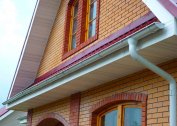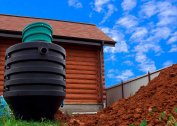The sewer network device is a complex engineering project and process that can threaten an environmental catastrophe or disaster in case of its improper implementation or design errors.
The most harmless problems associated with the sewage system may be the exit of sewage effluents to the outside during soil shifts, groundwater movements and its freezing during the onset of cold weather. And to larger consequences can be attributed the additional destruction of the pipes (with their inept laying) and the huge material costs of construction work associated with its repair.
What says SNiP 2.04.03–85
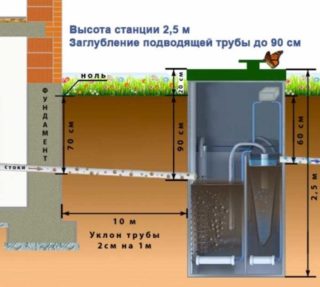 Building norms and rules for calculating the construction of sewer networks are regulated by SNiP 2.04.03-85, introduced in 1986.
Building norms and rules for calculating the construction of sewer networks are regulated by SNiP 2.04.03-85, introduced in 1986.
Despite a detailed description of issues such as neutralization of wastewater, deep and biological treatment facilities, wastewater disinfection, calculations and technological parameters of treatment mechanisms, filters, sedimentation tanks, pump, blower and ventilation stations used in the wastewater treatment system, lighting of design features of treatment systems and networks and much more, SNiP does not impose significant restrictions on the depth of the sewage pipes and systems for cleaning it.
SNiP in this matter recommends using common sense and experience in operating pipeline networks for this region, as well as using engineering calculations, taking into account the material and diameter of the pipes, terrain, soil and climatic conditions, and features of the work. In other words, we need special specialists who are well versed in this topic.
But in paragraph 4.8 of this SNiP there are still indications of the minimum depths of laying collectors and pipelines in the ground laid by the method of shield penetration from 3 meters and deeper, depending on the pipe materials.
What affects the depth and how it can be changed
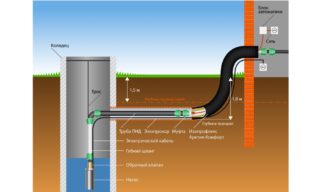 With a pipe cross section up to 0.5 m - the minimum depth of pipe laying in the soil from the pipe edge is 0.3 m, with a larger pipe section from the upper edge to the ground, at least 0.5 m must be retreated, and at least 0.7 m in the case of deep penetration of zero temperature into the soil . At the same time, it is stipulated that when choosing the smallest depth of the pipe, it is necessary to use engineering thermotechnical calculations.
With a pipe cross section up to 0.5 m - the minimum depth of pipe laying in the soil from the pipe edge is 0.3 m, with a larger pipe section from the upper edge to the ground, at least 0.5 m must be retreated, and at least 0.7 m in the case of deep penetration of zero temperature into the soil . At the same time, it is stipulated that when choosing the smallest depth of the pipe, it is necessary to use engineering thermotechnical calculations.
We see that SNiP 2.04.03-85 does not really help for calculating the depth of pipe laying in the design of sewers and for clarification, it makes sense to us to turn to the practice of designing and creating these networks.
Thus, a large-scale project drawn up by a specialist or design organization in relation to the required region is required, and experience in concluding an agreement with a contractor for the implementation of this project is also required, since in addition to checking the work, it is necessary to monitor compliance with environmental and sanitary standards.
Typically, in practice, the depth of the laying of sewer pipes should depend on the following circumstances and conditions:
- a method of laying pipe connections (laying sewer pipes can be external, or maybe with the use of reinforced concrete trays, and not only);
- from the climate, i.e., from the temperature of the soil, the conditions of freezing of the soil in the laying area and from its chemical composition;
- from the principle of the sewer network (gravity, pressure, high pressure, ...).
Practice shows that when laying pipes in the ground, using paragraph 4.8 of SNiP 2.04.03-85 makes sense under certain conditions, as developers may consider that his knowledge and use will relieve responsibility in case of problems, and dig deeper, thereby increasing financial costs for laying pipes, impractical for economic reasons.
Also, experts take into account the dynamic load on the sewage system when it is laid. A good example is a motorway or just a road that increases the load on the pipe laid underneath.Thus, the pipes are laid deep - 9 meters and deeper. To account for these circumstances, you need to create an engineering project.
Minimum and maximum depth, its calculation
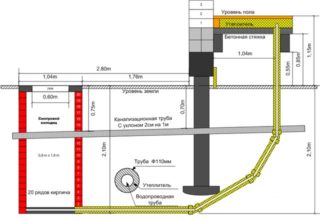 Note the cases that reduce the depth of the pipe:
Note the cases that reduce the depth of the pipe:
- there is a terrain (on flat terrain, the depth of the pipes will be the same, but on a more complex one it will depend on the landscape), there are also features of the existing pipeline, especially the connections of collectors with a septic tank and sewer pipes, taking into account the depth;
- there are features of laying sewer pipes in private houses operating on a gravity-free basis, taking into account the slope of the pipeline;
- the most important circumstance is the depth of soil freezing in a given area, because there are freezing marks that are given in SNiP 2.01.01.82 and with which the meteorological service is also familiar. When installing sewer connections (unlike the water supply system), the pipe laying depths are calculated by subtracting a certain distance from the freezing points, because the pipes have a flow with a plus temperature (+18 degrees Celsius even in cold weather, which avoids freezing). Therefore, in some cases it is even appropriate to lay pipes to a shallower depth with insignificant distances between collectors and pipe exits from the house;
- technological properties and features of materials for pipes are taken into account, in particular, high-strength steel and cast-iron pipes are laid at great depths. For polymer pipes, laying at a great depth is not acceptable, since this affects not only their technological properties, but also the entire system. And when purchasing pipes, their price, reliability, ease of assembly, delivery, and their other features are taken into account;
- during the design, special pipe cleaning devices are introduced into the system to protect against freezing (often this is pumping equipment). The working pump saves not only from stagnation, but also increases the temperature in the pipes, saving from icy particles;
- additional pipe insulation is used, sometimes the pipes are laid in a dry insulation (often it is fiberglass, rolled insulation material, wrapping pipes on all sides by more than 10 cm with an additional layer of waterproofing), additional soil filling or other conditions depending on the situation (one example this is a heating cable).
And what about the maximum depths of laying sewer pipes? For the operation of pipes, this is a very important indicator. Since on the one hand heat will be stored longer at a deeper depth, on the other hand it is important to take into account the comfort of the environment, the weight of the earth and its pressure on the pipes to assess the likelihood of damage and the complexity of the work performed along the entire length of the pipeline drain.
For certain types of soils (saturated with moisture or with a rocky base or rocky particles) SNiP recommends using pipe depths not exceeding 4 meters. And lay pipes to a depth of 5-8 meters in the case of dry land.
From the point of view of these standards, when exceeding certain depths of pipes, it is necessary and logical to use pallets or trays of reinforced concrete for reliable protection of pipes with increased operating loads and their greater safety.
In certain cases, with increased loads (such as laying pipes under an actively used roadway) or non-standard service life, corrugated rigid pipes based on polyethylene can be used.
In the formulations of SNiP, the nature of these standards for non-specialists is not entirely clear. Therefore, it is important to contact experienced specialists in the design of these systems. So the question of the optimal depths of sewer pipes must be addressed with the designers of these systems.SNiP 2.04.03-85, about which it was always mentioned in this article, largely gives only advisory instructions, leaving the question about the depths of laying sewer pipes under the responsibility of specialists.
Since this issue is very important and in addition to climate and soil geology, sanitary and epidemiological norms and environmental standards must be taken into account, no general instructions can give an answer to all decisions on the design of this system. The main thing is that the sewer system does not freeze in the cold, that it requires supervision and maintenance with immediate repair in case of emergency.
